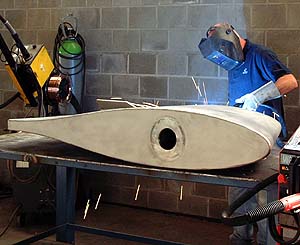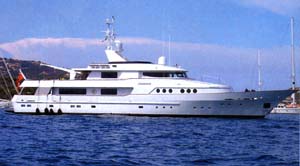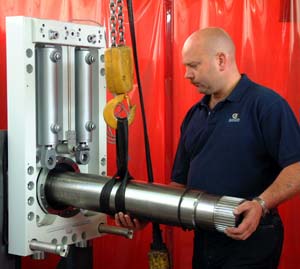FROM EVOLUTION
TO REVOLUTION
By: REG POTTERTON

| STABILITY AT ANCHOR
FROM EVOLUTION By: REG POTTERTON |

|
THERE WAS A STEADY SWELL HEAVING THROUGH THE ANCHORAGE THAT DAY, AND THE YACHTS IN THE BAY ROLLED AND WALLOWED IN ITS WAKE. ON ONE STATELY MOTOR YACHT THE OWNER AND GUESTS WERE ABOUT TO SIT FOR LUNCH AT THE AFT DECK DINING TABLE WHEN THE LOBSTER BISQUE AND SOME OF THE OWNER’S CHOICEST CRYSTAL SLID OFF THE TABLE AND CRASHED INTO THE SCUPPERS. |
A board a 160' tridecker that had just dropped
anchor, the intercom beeped in the wheelhouse. It was
the owner's wife, calling from the master suite and
sounding a little queasy. "Captain," she said, "I'm looking
out of the window and the horizon is moving. Please
do something about it." The captain touched a button on the console. Around him every boat in sight was still pitching and rolling, but on the tridecker serenity reigned. Apart from the gentlest up-and-down motion it was almost as if the boat sat on dry land. This was because her captain had just activated technology's latest—and by many accounts most effective —remedy for marine motion sickness: digitally-controlled stability at anchor. |
| Until a couple of years ago it was taken for granted
that anchored yachts rolled when the sea rolled.
Depending on conditions the motion could be mild or
severe, and those aboard had no choice but to put up
with it or raise the hook and go somewhere else. While
marine technology advanced on many fronts, anti-roll
technology that might eliminate or reduce motion discomfort
at anchor developed slowly. Some of the solutions to the problem owed more to wishful thinking than to practicality, including a 19th century design for a fully-gimbaled interior that tended to get stuck on the uproll. Among later developments: multiple gyroscopes coupled with control units the size of refrigerators; unwieldy flopper-stoppers, and space-eating, U-shaped anti-roll water tanks. None of them seems to be as practical or as efficient as high-speed stabilizer fin systems fitted with sensors that monitor angle, velocity and acceleration, and instantly transmit signals via digital controls that direct a counteractive response by the fins. In marine engineering circles this system, first installed by KoopNautic in the motor yacht Boadicea, a 230-footer launched in 1999 at Amels, has been hailed as the most revolutionary innovation in stability while anchored since the invention of the anchor itself. (For the sake of simplicity, such systems are abbreviated here as OAS, for On Anchor Stability.) The seed for an OAS fin system was planted by Sjoerd Veeman, Managing Director of Amels, and it was prompted by the request of Boadicea's owner that his new boat provide ultimate stability in all conditions, underway and anchored. The owner initially wanted anti-roll tank OAS but decided against this because these installations can take up as much as five percent of a boat's interior volume. |
New fins awaiting for shipment from factory.

The M/Y
Faribana |
 Assembling a stabilizer fin unit. Go To Page 2 |
Veeman called Theo Koop, founder of KoopNautic stabilizer
systems, and Koop called Hans Ooms, Professor
of Electronics at Delft University, a Dutch counterpart of
MIT. Ooms is a pioneer in the design of stabilizer controls.
Koop credits him with designing every KoopNautic
control since Koop entered the stabilizer field. “I call him
the father of our controls,” Koop told YIM. “The basic
idea (for OAS) came from Veeman but it was Hans Ooms
who designed and engineered the electronic controls
that made it work on Boadicea. No sooner had Boadicea, the world’s first fin-fitted OAS yacht, been launched than she sailed off to the South Pacific. But word of the system’s successful performance, as reported by crew members, attracted the attention of Quantum Marine Engineering (QME), a small and resourceful company in South Florida known for its fin stabilizer expertise and the design and manufacture of integrated hydraulic systems and rapid response electronic controls. |
| NOTE: We have used the generic designation OAS (On Anchor Stability) to avoid repetition of the proprietary acronyms used by Naiad/KoopNautic (DATUM, Dynamic Adaptive Technology for Universal Motion control) and by Quantum (ARC, Adaptive Ride Control). | Magazine Article in a 270K PDF Adobe Acrobat file. |
| Broker John DeCaro |
| Fort Lauderdale, FL 33316 USA |
| Telephone: 954-671-0107 |
| info@buyexploreryachts.com |
| HOME | DESIGN | BROKERAGE | CREW | NEWS | F.A.Q.s | BIO | LINKS | EM@IL |